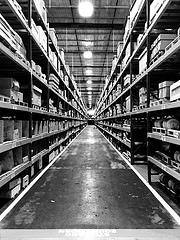
(Courtesy Flickr)
Whether you are managing a brand new warehouse or one that’s been around for years, the one thing you can’t take for granted is shelving. The shelves you select need to be able to hold the amount of weight piled on them; they must allow easy access to the items they hold; they must be sturdy enough to take abuse from forklifts that ram into them; they need to be visually appealing; they need to hold a lot of items and be safe to use; and on and on.
You need to understand how the warehouse operates; what type of products are being stored, whether or not the physical construction of the shelves assures efficient picking and loading, whether its size fits in with the physical layout of the warehouse, and on and on.
Here are a number of things you need to consider when inspecting shelves either in person at a store or online.
· The weight rating of the shelf. Keep in mind that the rating is based on the even distribution of items on a shelf. So if a shelf has the capability of holding 400 pounds, then it is best for holding 10 items of 40 pounds spread evenly across the entire surface. It probably wouldn’t hold one 400 pound item positioned in the center of the shelf.
· The shelf needs to accommodate what is being stored. If you expect to store 12-inch wide boxes in a configuration of three across, then a quick calculation tells you that you will require a shelf that is 36-inches wide. However, such an arrangement could make a box awkward to take off or put on and adversely affect a laborer’s productivity
· The height of the shelf must properly fit in the warehouse. Select shelves that fit within the confines of the warehouse and still allow you to pile inventory on the top shelf. Make certain that the height of the shelf doesn’t encounter lighting fixtures, pipes, a sprinkler system, or any other objects that might be attached to the ceiling.
· Consider buying a stock sized shelf. Shelves come in a number of stock sizes one of which could prove appropriate to your specific situation. Common standard sizes include 18-inches by 36-inches, 18-inches by 48-inches, 24-inches by 36-inches and 24-inches by 48-inches. Height varies from 72-inches to 96-inches. It’s best to consult with a supplier who can answer questions concerning this.
Shelves come in three basic styles – rivet, steel clip, and wire.
If you are looking for a multipurpose shelf that is strong and easy to assemble, you may want to consider the rivet shelf. These shelves have a weight capability of up to 1,850 pounds, offers easy access, and good stability. It is made of solid steel frame and features 5/8-inch particleboard, wire, plywood, or a solid steel deck.
Advantages include easy installation, the most sizes, and higher weight capacities. Disadvantages include its visual appearance, and its weight. Moreover, it costs more to ship.
Steel shelving is ideal for high-density applications and is offered in open and closed styles. Back and sway braces keep it steady. It is easy to customize and accessorize and include built-in bin; and multiple types of dividers, doors, and modular drawer inserts. These shelves are more expensive than the other options, and they are a little more difficult to install.
If cosmetics and accessibility are important to you, then you may want wired shelves. This style of shelf has open construction and open back and sides so there is access from all four sides.
Advantages include easy adjustability and several configurations. However, it is more expensive than rivet and metal shelving, there are a limited number of sizes, and its maximum weight capability is about 1,200 pounds.
